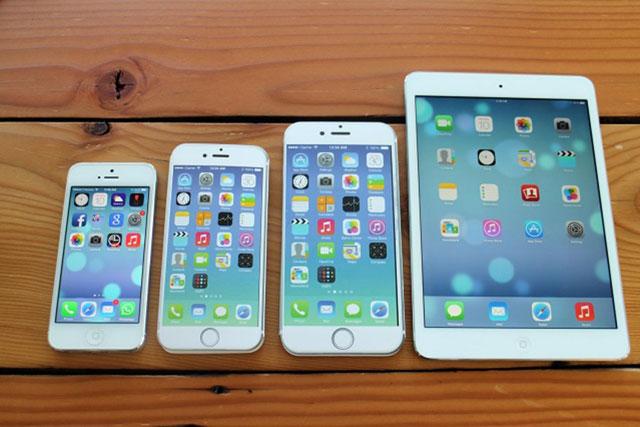You are here
What to do if phones fill up with photos
By AP - May 13,2015 - Last updated at May 13,2015

NEW YORK — Shoot enough photos and videos, and your phone will eventually fill up. Many phones don’t let you add storage, and moving images to a personal computer is complicated for many people.
Help comes from Yahoo and Apple. Yahoo’s Flickr and Apple’s iCloud Photo Library will automatically transfer photos and videos to your online account, so you get a backup and more space on your device.
Flickr
Flickr offers virtually unlimited online storage for free — 1 terabyte, or as Yahoo puts it, about five photos a day for the next 60 years. For many people, that generosity has sat unused, so Yahoo released tools this month to automate image transfers.
With Flickr’s app for iPhones, iPads and Android devices, old and new images alike are automatically copied to your online account. Free up space by deleting the original files from your phone. You’ll still be able to edit and share images through Flickr’s app, and you can retrieve the originals from Flickr anytime.
Meanwhile, Flickr’s software for Mac and Windows computers will continually scan and upload images, including ones you add later.
Regardless of the source, all photos and videos are viewable in one collection through a Web browser or Flickr’s mobile app. The newest images are on top, but you can use Flickr’s smart sorting tools under its “Magic View”. Software analyses and categorises images based on what’s in them, such as food and flowers. A search tool lets you filter by such attributes as colours in the picture and the image’s orientation.
To free up space, you need to delete files from your phone after getting them to Flickr, which means you also need to keep track of which ones have already been transferred. Also, while Flickr can categorise people shots based on whether they contain kids or groups, it doesn’t do face detection. You can’t pull up photos of just your mom or your best friend.
Flickr is still rolling out the features to all of its users. I’ve encountered some hiccups, including videos not uploading consistently.
And after a few days, Flickr still hasn’t finished transferring all of my photos. If your collection is sizable like mine, it can take days or weeks.
To get this: Just get Flickr’s app from your phone’s app store. Go to http://flickr.com/tools/downloadmac for the Mac software and http://flickr.com/tools/downloadwindows for Windows.
iCloud photo library
Launched last month, iCloud Photo Library is Apple’s way of unifying your photo collection online. It works with Apple’s Photos app for organising and editing those images on Mac and mobile devices.
Apple keeps a full-resolution version online while downgrading what’s on your device when space is low. You get the original back when you need it. Otherwise, it’s not taking up as much space. All this is automatic, so you don’t need to mess with deleting originals and potentially deleting the wrong ones.
You’re limited to Apple devices — iPhones, iPads and Macs — and you’re charged for storage once you hit 5 gigabytes, or roughly 3,000 photos. It costs 99 cents a month for 20 gigabytes, though you might need more if your phone is already full.
Unlike Flickr, Apple can sort images based on specific individuals in them, though it doesn’t do object recognition, such as automatically identifying a dog in a picture. Unlike Flickr, Apple can handle RAW file formats favoured by many professionals with high-end cameras. It’s not an issue, though, if you’re just shooting with the phone.
To get this: iCloud Photo Library is built into the Photos apps that come with Mac and iOS operating systems. There’s no separate download once you have the latest system updates. You simply need to turn the feature on when prompted.
And the rest...
With Google’s Auto Backup and Amazon’s Cloud Drive, you have to upload photos from PCs manually. Automatic transfers are limited to Apple and Android phones.
Google offers free unlimited storage in a reduced resolution. Otherwise, full-resolution images count towards a free allotment shared with Gmail and other Google services. Amazon’s Cloud Drive is $12 a year — waived for members of its $99-a-year Prime service. That gives you unlimited photo storage only. It’s $60 a year if you want unlimited videos, too.
With all of these services, images are kept private — for your eyes only — until you specific otherwise.
Flickr is the only one that’s truly free and compatible with multiple systems. But if you have an Apple device and don’t mind paying, iCloud Photo Library is the easier one to use.
Related Articles
Apple’s Mac operating system is getting a new design and better ways to exchange files, while new features in the software for iPhones and iPads include one for keeping tabs on your health.
If actress Jennifer Lawrence and model Kate Upton knew little about the Internet “cloud,” they would not be alone, but the recent theft of their intimate photos has served as a wake-up call.
The scores of new features in Apple’s software update for mobile devices can be boiled down to one word: unity.

















